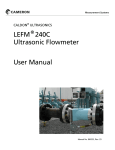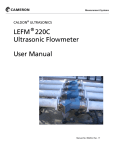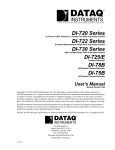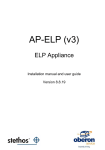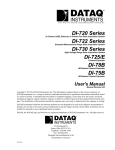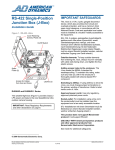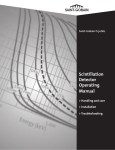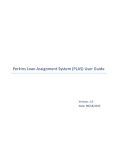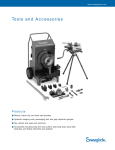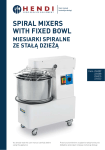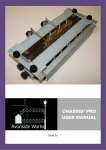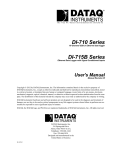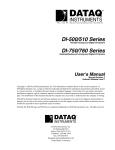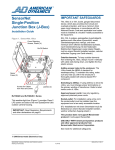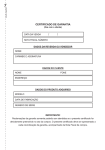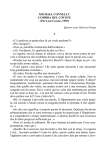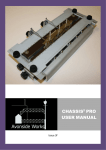Download LEFM 280C Ultrasonic Flowmeter User Manual
Transcript
LEFM 280C User Manual IB0510 Rev. 06 CALDON® ULTRASONICS ® LEFM 280C Ultrasonic Flowmeter User Manual Manual No. IB0510 Rev. 06 IB0510 Rev. 06 LEFM 280C User Manual Caldon is a trademark of Cameron International Corporation (“Cameron”). LEFM is a registered trademark of Cameron. ModBus is a registered trademark of ModBus Organization, Inc. Copyright © 2008 Cameron International Corporation (“Cameron”). All information contained in this publication is confidential and proprietary property of Cameron. Any reproduction or use of these instructions, drawings, or photographs without the express written permission of an officer of Cameron is forbidden. All Rights Reserved. Printed in the United States of America Manual No. IB0510 Rev. 06 November 2008 LEFM 280C User Manual IB0510 Rev. 06 TABLE OF CONTENTS INTRODUCTION 1.0 III EQUIPMENT SPECIFICATION 1 1.1 LEFM 280C EQUIPMENT .....................................................................................................................1 1.1.1 LEFM TRANSMITTER..........................................................................................................................1 1.1.2 LEFM 280C METER BODY SECTION.................................................................................................3 1.2 LEFM 280C MODEL NUMBER............................................................................................................4 1.2.1 LEFM 280C MODEL NUMBER............................................................................................................4 1.2.2 LEFM 280C LT MODEL NUMBER (CRYOGENIC TEMPERATURE RANGE) ..............................4 1.2.3 LEFM 280C PART CODE ......................................................................................................................5 1.3 LEFM 280C SPECIFICATIONS ............................................................................................................7 1.3.1 LEFM 280C TRANSMITTER ................................................................................................................7 1.3.2 APPROVALS – TRANSMITTER, LEFM 280C-T-….-EX ...................................................................8 1.3.3 APPROVALS – METER BODY, LEFM 280C-M AND LEFM 280C-LT-M .......................................8 1.3.4 ENVIRONMENT (TRANSMITTER AND METER BODY) ..............................................................10 1.3.5 LEFM 280C AND 280C-LT WITH J-BOXES - METER BODY SPECIFICATIONS........................11 1.3.6 LEFM 280C LT METER BODY SPECIFICATIONS (WITHOUT J-BOXES)...................................15 2.0 INSTALLATION 17 2.1 TRANSMITTER ...................................................................................................................................17 2.1.1 TRANSMITTER MOUNTING.............................................................................................................17 2.1.2 FIELD TERMINATIONS .....................................................................................................................18 2.1.3 TERMINATIONS - DIGITAL SIGNALS ............................................................................................18 2.1.4 GROUNDING/EARTHING (METER BODY AND TRANSMITTER)..............................................18 2.2 FLOW METER BODY .........................................................................................................................19 2.2.1 METER BODY TERMINATIONS.......................................................................................................19 2.2.2 UPSTREAM AND DOWNSTREAM PIPING .....................................................................................19 2.2.3 FLOW DIRECTION..............................................................................................................................19 2.2.4 GAS (AIR) IN THE FLOW STREAM..................................................................................................20 2.3 METER INSTALLATION CHECK-OUT............................................................................................31 3.0 OPERATION 33 3.1 MEASURING VELOCITIES................................................................................................................33 3.2 MEASURING FLOWRATE .................................................................................................................34 3.3 LEFM 280C TRANSMITTER ..............................................................................................................35 3.4 LEFM 280C FAULT DETECTION ......................................................................................................35 November 2008 Page i Table of Contents IB0510 Rev. 06 LEFM 280C User Manual 3.5 GROSS TO NET FLOWRATE CONVERSION ..................................................................................36 3.6 REMOTE DATA COMMUNICATIONS .............................................................................................37 4.0 MAINTENANCE 39 4.1 INTRODUCTION .................................................................................................................................39 4.2 GENERAL INSPECTIONS - PREVENTATIVE MAINTENANCE PROCEDURES ........................39 4.3 POWER SUPPLY VOLTAGE TROUBLESHOOTING AND MAINTENANCE ..............................41 4.4 METERING SECTION AND TRANSDUCER CABLES ...................................................................44 4.5 TRANSDUCER INSTALLATION PROCEDURE ..............................................................................45 4.6 ANALOG INPUT ALIGNMENT AND VERIFICATION PROCEDURE ..........................................51 4.7 ANALOG OUTPUT VERIFICATION .................................................................................................52 4.7.1 ANALOG SCALING ............................................................................................................................52 4.7.2 PULSE VERIFICATION TESTS..........................................................................................................52 5.0 TROUBLESHOOTING AND DIAGNOSTICS FOR THE ULTRASONICS 55 5.1 DIAGNOSTICS.....................................................................................................................................55 5.2 PATH TROUBLESHOOTING .............................................................................................................57 5.2.1 PATH REJECT STATUS......................................................................................................................57 5.3 REPROGRAMMING THE TRANSMITTER ......................................................................................59 5.3.1 MODBUS ID AND BAUD RATE........................................................................................................60 6.0 RECOMMENDED SPARE PARTS 63 6.1 DOMESTIC (US AND CANADA).......................................................................................................63 6.2 INTERNATIONAL ...............................................................................................................................63 7.0 7.1 APPENDIX A 65 ATEX CERTIFICATIONS (DOCUMENT IB0613) ............................................................................65 Table of Contents Page ii November 2008 LEFM 280C User Manual IB0510 Rev. 06 INTRODUCTION The Caldon® LEFM 280C Ultrasonic Flow Meter is a highly sophisticated flow measurement system. It employs the ultrasonic transit time method to measure fluid velocity and volumetric flowrate. It contains advanced signal and data processing circuitry to achieve high accuracy and repeatability. It also contains an automatic self-checking system to continuously verify that it is performing properly and to initiate warnings and alarms when unsatisfactory conditions are detected. For ease of troubleshooting, it provides via ModBus easy to interpret diagnostic information. It is recommended that before performing system verification and repair procedures, personnel receive general training from Cameron. Contact Cameron's Measurement Systems division for information on training programs. A complete range of support services are offered. For additional information or assistance on the application, operation or servicing of the LEFM 280C, write or call, or visit www.c-a-m.com/flo. CAUTION NO OPERATOR ACCESS IS PERMITTED IN THE UNIT. SERVICE SHOULD ONLY BE PERFORMED BY QUALIFIED PERSONNEL. IF THE EQUIPMENT IS USED IN A MANNER NOT SPECIFIED BY THE MANUFACTURER, THE PROTECTION PROVIDED BY THE EQUIPMENT MAY BE IMPAIRED. November 2008 Page iii Introduction IB0510 Rev. 06 Introduction LEFM 280C User Manual Page iv November 2008 LEFM 280C User Manual 1.0 IB0510 Rev. 06 EQUIPMENT SPECIFICATION 1.1 LEFM 280C Equipment LEFM 280C Flow Measurement Systems consist of two types of equipment. 1. 2. 1.1.1 LEFM 280C Transmitters LEFM 280C Meter body or Metering Section, including transducers, cables for transducers, temperature transmitters, and pressure transmitters (optional) LEFM Transmitter Each LEFM 280C transmitter is a wall mount unit with the following special features: • Standard Outputs: Pulse (0-5 V standard); the meter K factor is programmable. The standard factory delivered K factors are listed in Table 1-1 below. • Optional Analog Inputs of: Product temperature (RTD, 4-20, or 0-20mA) Product pressure (4-20, or 0-20 mA) Product density (Frequency, 4-20 or 0-20 mA) • Optional Analog Outputs of: Flow (4-20, or 0-20 mA) Sound Velocity (4-20, or 0-20 mA) Product Specific Gravity (4-20, or 0-20 mA) Temperature (4-20, or 0-20 mA) Any analog output may be mapped to any ModBus input register. The LEFM 280C transmitter contains signal processing and digital computing circuitry, and power supply equipment. There are two LEFM280C transmitters delivered with each LEFM280C meter. The transmitters are referred to as Transmitter A and Transmitter B. Transmitter A is connected to acoustic paths numbered 14. Transmitter B is connected to acoustic paths numbered 5-8. The two transmitters are completely independent of each other and are in effect two LEFM240C meters (See Figure 1-1). November 2008 Page 1 Equipment Specification IB0510 Rev. 06 LEFM 280C User Manual 5UP 1DN 1UP 5DN Transmitter A Transmitter B Figure 1-1: LEFM280C System Overview Equipment Specification Page 2 November 2008 LEFM 280C User Manual Size Inches 4 6 8 10 12 14 16 18 20 24 26 28 30 32 34 36 DN 100 150 200 250 300 350 400 450 500 600 650 700 750 800 850 900 IB0510 Rev. 06 Maximum Flow BPH K Factor (P/bbl) Maximum Flow m3/h K Factor (P/m3) 2,050 4,650 8,150 12,800 19,300 23,600 28,700 41,000 50,000 72,000 87,000 100,000 115,000 130,000 150,000 165,000 2,000 1,000 500 350 250 200 150 100 85 60 45 40 35 30 25 25 325 740 1,290 2,030 3,070 3,750 4,560 6,500 7,900 11,500 13,900 16,200 18,700 21,300 24,200 27,200 12,600 6,300 3,150 2,200 1,570 1,000 940 630 530 380 280 240 220 185 165 145 Table 1-1: Standard Delivered K Factors 1.1.2 LEFM 280C Meter Body Section The Meter Body Section or Metering Section, as it is sometimes referenced, contains the acoustic transducers that transmit and receive the ultrasonic pulses that pass through the fluid. The meter body is a specially designed section of pipe, which contains eight pairs of housings into which the ultrasonic transducers are installed. The housings are positioned in a configuration to provide one plane of four chordal paths at 45° to the flow direction and another plane of four paths at a 90° to the first and are spaced in accordance with the Gaussian Method of flow integration. 1.1.2.1 Transducers Each transducer transmits and receives ultrasonic pulses, (typically 0.5MHz, 1.0 MHz or 1.6 MHz). The transducer modules contain piezoelectric crystals and are contained in housings that are designed to permit module removal from their housings for maintenance without affecting the pressure boundary. November 2008 Page 3 Equipment Specification IB0510 Rev. 06 LEFM 280C User Manual 1.2 LEFM 280C Model Number Each LEFM 280C has a Model Number and part code that completely defines the construction and features of that flow meter. The following subsections define the Model Number and part codes. 1.2.1 LEFM 280C Model Number LEFM 280C-TA- 6- 40-SS-150-EX Enclosure Type Meter Type TA = Transmitter A GP = NEMA 4X TB = Transmitter B EX = Aluminum, Explosion Proof M = Meter Body Meter Size, Inches ANSI Flange Rating 150 300 600 900 1500 Schedule: 40 STD 80 100 120 160 XXS 0.625 0.750 0.875 1.2.2 Pipe Material SS = Stainless Steel CS = Carbon Steel DS = Duplex Stainless Steel LEFM 280C LT Model Number (Cryogenic Temperature Range) LEFM 280C LT-M-6- 40-SS-150-EX Enclosure Type Meter Type M = Meter Body GP = NEMA 4X EX = Aluminum, Explosion Proof Meter Size, Inches ANSI Flange Rating 150 300 600 900 1500 Schedule: 40 STD 80 100 120 160 XXS 0.625 0.750 0.875 Equipment Specification Pipe Material SS = Stainless Steel CS = Carbon Steel DS = Duplex Stainless Steel Page 4 November 2008 LEFM 280C User Manual 1.2.3 IB0510 Rev. 06 LEFM 280C Part Code Meter Body Part Code Key H 8 S 0 6 4 S AW A 1 6 0 AC H = Hydrocarbon Product Line 0 = Standard / C = Custom Product Type: 2 = LEFM220C 4 = LEFM240C 8- LEFM280C S = SoundTrack E = LEFM200E Approvals (Pressure Boundary/Electrical) A = ASME/CSA B = ASME/ATEX C = PED/ATEX Transducer Frequency (10*MHz) S = Spool Housing Size: A = 0.5" B = 1" C = 0.62" D = 1.05" E = 0.75" (Cryogenic Temperatures) Size (Inches) Schedule: 4 = Sch. 40 S = Standard 8 = Sch. 80 0 = 100 2 = 120 6 = 160 X = XXS T = 0.625 for 26" Meter T = 0.750 for 28" and 32" Meter T = 0.875 for 34" and 36" Meter Flange Type W = Weld Neck Raised Face R = Weld Neck RTJ Face Flange Class: A = ANSI Class 150 B = ANSI Class 300 C = ANSI Class 600 D = ANSI Class 900 E = ANSI Class 1500 Material: S = Stainless Steel C = Carbon Steel D = Duplex Stainless Steel November 2008 Page 5 Equipment Specification IB0510 Rev. 06 LEFM 280C User Manual Transmitter Part Code Key H8 TG2 1 6 1AB0 0 0 0C H = Hydrocarbon Product Line 0 = Standard / C = Custom Serial Options 0 = IR Board 8 = RS-485 / No IR Board N = No IR Board B = IR Board / RS-485 Product Type: 2 = LEFM220C 4 = LEFM240C 8 = LEFM280C S = SoundTrack T = Transmitter Analog Output Options 0 = None 1 = A/O 1 2 = A/O 2 3 = A/O 1, A/O 2 4 = A/O 3 5 = A/O 1, A/O 3 6 = A/O 2, A/O 3 7 = A/O 1, A/O 2, A/O 3 8 = A/O 4 9 = A/O 1, A/O 4 A = A/O 2, A/O 4 B = A/O 1, A/O 2, A/O 4 C = A/O 3, A/O 4 D = A/O 1, A/O 3, A/O 4 E = A/O 2, A/O 3, A/O 4 F = A/O 1, A/O 2, A/O 3, A/O 4 Enclosure Type G = NEMA 4X X = Explosion Proof, Al S = Explosion Proof, SS Power Supply 1 = 120 VAc 2 = 240 VAc 3 = 24 VDc Transducer Frequency (10*MHz) Analog Input Options 0 = None 1 = A/I 1 2 = A/I 2 3 = A/I 1, A/I 2 4 = A/I 3 5 = A/I 1, A/I 3 6 = A/I 2, A/I 3 7 = A/I 1, A/I 2, A/I 3 8 = A/I 4 9 = A/I 1, A/I 4 A = A/I 2, A/I 4 B = A/I 1, A/I 2, A/I 4 C = A/I 3, A/I 4 D = A/I 1, A/I 3, A/I 4 E = A/I 2, A/I 3, A/I 4 F = A/I 1, A/I 2, A/I 3, A/I 4 Equipment Specification Page 6 November 2008 LEFM 280C User Manual IB0510 Rev. 06 1.3 LEFM 280C Specifications 1.3.1 LEFM 280C Transmitter Material: Explosion Proof NEMA4X Aluminum Stainless Steel Weight Net Weight (1 Transmitter):NEMA 4X - 30 lbs. (13.6 kg) Explosion Proof - 120 lbs. (54.5 kg) (See following figures for dimensions) Power Requirements (each transmitter) Voltage Supply Required: 24 VDC or, 120 VAC, 50/60 Hz or, 230 VAC, 50/60 Hz Current Draw: 24 VDC – 3.0 Amps 120 VAC – 0.8 Amps 230 VAC – 0.6 Amps Power Consumption: 20W (80W with heaters active) Cable Lengths Standard: Extended Range: 15 feet (approximately 5 meters); lengths up to 200 feet (61 meters) can be ordered Special cables can be used for runs up to 1000 feet (300 meters). Contact the Cameron Measurement Systems division Engineering department to discuss the needs of the application. Pulse Outputs/Communications Pulse Output: Alarm Status: Serial Communications: 0-5 Volts 5 Volts (Normal), 0 Volts (Alarm) RS-232 (typical, RS-422 or RS-485 options available) ModBus Protocol, see Caldon ModBus Specifications Analog Outputs: 4-20mA or 0-20mA (max load 650 Ohms), up to 4 (each transmitter). Analog Inputs: 4-20mA, 0-20mA, RTD, or Frequency, up to 3 total (each transmitter). Meter Body Temperature RTD is standard. November 2008 Page 7 Equipment Specification IB0510 Rev. 06 1.3.2 LEFM 280C User Manual Approvals – Transmitter, LEFM 280C-T-….-EX Hazardous Area Approvals: (USA and Canada) Class I Div I Groups C and D, Conforms to UL Std 1203, Std UL 61010-1, CSA Std 22.2 No. 30, CSA Std 22.2 No. 61010.1 Hazardous Area Approvals: (ATEX) 1.3.3 Approvals – Meter Body, LEFM 280C-M and LEFM 280C-LT-M USA and Canada LEFM 280C-M Manifold Part Number 202B264HXX Class I Div I Groups B, C and D, Conforms to CAN/CSA-C22.2 No.0-M91, CSA Std C22.2 No.30-M1986, CAN/CSA-C22.2 No. 94-M91, CSA Std C22.2 No.142-M1987, UL Std No. 50, ANSI/UL Std No.508, UL Std No.1203 Temperature Range: -40 deg C to 140 deg C Equipment Specification Page 8 November 2008 LEFM 280C User Manual IB0510 Rev. 06 ATEX LEFM 280C-M Manifold Part Number 202B264-W-HXX Explanation of Part Number Code and Temperature Range (ATEX only) Defines the different glands/seals that may be used with the device Where: “W” is set to D – the temperature range is: TA = -50°C to 93°C “W” is set to E – the temperature range is: TA = -50°C to 80°C “W” is set to F – the temperature range is: TA = -50°C to 93°C “W” H”XX” Defines the different sizes (“XX” can be any value from 01 to 16) ATEX LEFM 280C-LT-M (Wide Range Temperature) Manifold Part Number 202B582”WYZ”-H”**” “W” Explanation of Part Number Code Defines the different glands/seals that may be used with the device Where: “W” is set to D – the temperature range is: TA = -170°C to 130°C “W” is set to E – the temperature range is: TA = -170°C to 130°C “W” is set to F – the temperature range is: TA = -170°C to 130°C “Y” Defines the different whether the device has an elbow in the fittings Where: “Y” is set to R – There is an elbow in the fittings “Y” is set to S – There is no elbow in the fittings “Z” Defines the different whether the device has a Tee or an adaptor in the fittings Where: “Z” is set to T – There is a tee in the fittings “Z” is set to F – There is an adaptor used instead of a tee in the fittings H”**” Defines the different sizes (“**” can be any value from 01 to 40) November 2008 Page 9 Equipment Specification IB0510 Rev. 06 LEFM 280C User Manual Note: The ambient temperature range for the ATEX approved glands is limited to -50°C. The meter body is rated to -170°C and must be under thermal insulation. WARNING The ATEX certificates are located in an appendix of this manual and define the conditions for safe use of the meter manifold and the transmitter. The temperature ranges listed are for the enclosures indicated on the certificate. The temperature limit of the meter assembly is dependent on the temperature limits for the components used to connect the meter to the electronics and may limit the temperature limits for the assembled meter. See the meter nameplate for the temperature limit of the system as assembled. 1.3.4 Environment (Transmitter and Meter body) Storage Temperature Transducer Cable: -40°F (-40°C) to 140°F (60°C) Transmitter: -40°F (-40°C) to 158°F (70°C) Meter body: 280C (all models) -40°F (-40°C) to 176°F (80°C) 280C LT (Cryogenic) -40°F (-40°C) to 176°F (80°C) Note: For storage temperature, the meter body limits have been set by the limiting ambient rating of any seal/gland or J-box that could be used with the flow meter. The operating temperatures are defined in the previous section. Operating Temperatures (See Approvals Section) Operating Pressures Meter body: Equipment Specification Max working is listed on meter nameplate (surge pressures in excess of flange max working pressure rating, must be evaluated) Page 10 November 2008 LEFM 280C User Manual 1.3.5 IB0510 Rev. 06 LEFM 280C and 280C-LT with J-Boxes - Meter Body Specifications Figure 1-2: Construction Outline Drawing (280C and 280C-LT Temperature Range) November 2008 Page 11 Equipment Specification IB0510 Rev. 06 LEFM 280C User Manual Figure 1-3 (Addendum): ATEX Only - Construction of Manifold to Junction Box Connection Note: The specific ATEX approved cable gland, as specified on ATEX Certificate, must be used. (See Appendix A of this manual for a copy of the ATEX Certificate). Equipment Specification Page 12 November 2008 PIPE SIZE Inches (DN) 4 (100) 4 (100) 4 (100) 4 (100) 4 (100) 6 (150) 6 (150) 6 (150) 6 (150) 6 (150) 8 (200) 8 (200) 8 (200) 8 (200) 10 (250) 10 (250) 10 (250) 10 (250) 12 (300) 12 (300) 12 (300) 12 (300) 14 (350) 14 (350) 14 (350) 14 (350) 16 (400) 16 (400) 16 (400) 16 (400) * FLANGE Inches 150 18.0 300 18.8 600 20.5 900 21.5 1500 22.3 150 20.5 300 21.3 600 23.2 900 25.0 1500 27.5 150 24.0 300 24.8 600 27.0 900 29.3 150 26.0 300 27.2 600 30.5 900 33.0 150 29.5 300 30.7 600 33.2 900 36.8 150 32.0 300 33.2 600 35.5 900 39.3 150 33.5 300 35.0 600 38.0 900 41.5 A (mm) (457) (477) (521) (546) (565) (521) (540) (590) (635) (699) (610) (629) (686) (743) (660) (692) (775) (838) (749) (781) (844) (934) (813) (844) (902) (997) (851) (889) (965) (1054) Inches 4.6 4.6 4.6 4.6 4.6 5.4 5.4 5.4 5.4 5.4 6.4 6.4 6.4 6.4 7.6 7.6 7.6 7.6 8.6 8.6 8.6 8.6 9.4 9.4 9.4 9.4 10.3 10.3 10.3 10.3 B (mm) (117) (117) (117) (117) (117) (137) (137) (137) (137) (137) (163) (163) (163) (163) (193) (193) (193) (193) (218) (218) (218) (218) (237) (237) (237) (237) (262) (262) (262) (262) Inches 4.4 4.8 5.7 6.2 6.5 4.9 5.2 6.2 7.1 8.4 5.6 6.0 7.1 8.2 5.4 6.0 7.7 8.9 6.2 6.8 8.0 9.8 6.7 7.3 8.4 10.3 6.5 7.2 8.7 10.5 C (mm) (112) (121) (144) (156) (166) (123) (133) (158) (180) (212) (142) (152) (180) (209) (137) (153) (194) (226) (156) (172) (204) (248) (169) (185) (213) (261) (164) (183) (221) (265) Inches 9.0 10.0 10.8 11.5 12.3 11.0 12.5 14.0 15.0 15.5 13.5 15.0 16.5 18.5 16.0 17.5 20.0 21.5 19.0 20.5 22.0 24.0 21.0 23.0 23.8 25.3 23.5 25.5 27.0 27.8 D (mm) (229) (254) (273) (292) (311) (279) (318) (356) (381) (394) (343) (381) (419) (470) (406) (445) (508) (546) (483) (521) (559) (610) (533) (584) (603) (641) (597) (648) (686) (705) Inches 13.5 14.0 14.4 14.8 15.2 15.4 16.1 16.9 17.4 17.6 17.6 18.4 19.1 20.1 19.9 20.7 21.9 22.7 22.4 23.2 23.9 24.9 24.0 25.0 25.4 26.2 26.4 27.4 28.2 28.5 F (mm) (344) (357) (366) (376) (385) (390) (409) (428) (441) (447) (447) (466) (485) (511) (506) (525) (557) (576) (569) (588) (607) (633) (611) (636) (646) (665) (671) (696) (715) (725) Inches 6.5 6.5 6.5 6.5 6.5 6.5 6.5 6.5 6.5 6.5 6.5 6.5 6.5 6.5 6.5 6.5 6.5 6.5 6.5 6.5 6.5 6.5 6.5 6.5 6.5 6.5 6.5 6.5 6.5 6.5 G (mm) (165) (165) (165) (165) (165) (165) (165) (165) (165) (165) (165) (165) (165) (165) (165) (165) (165) (165) (165) (165) (165) (165) (165) (165) (165) (165) (165) (165) (165) (165) Inches 180.0 180.0 180.0 180.0 180.0 180.0 180.0 180.0 180.0 180.0 180.0 180.0 180.0 180.0 180.0 180.0 180.0 180.0 180.0 180.0 180.0 180.0 180.0 180.0 180.0 180.0 180.0 180.0 180.0 180.0 L (mm) (4572) (4572) (4572) (4572) (4572) (4572) (4572) (4572) (4572) (4572) (4572) (4572) (4572) (4572) (4572) (4572) (4572) (4572) (4572) (4572) (4572) (4572) (4572) (4572) (4572) (4572) (4572) (4572) (4572) (4572) lbs. 185 202 236 254 298 279 313 391 449 559 474 530 636 746 714 792 990 1130 987 1107 1277 1477 1265 1405 1605 1845 1467 1687 1967 2177 November 2008 (kg) (84) (92) (107) (115) (135) (126) (142) (177) (204) (253) (215) (240) (289) (338) (324) (359) (449) (513) (448) (502) (579) (670) (574) (637) (728) (837) (666) (765) (892) (988) Weight LEFM 280C User Manual IB0510 Rev. 06 Dimensions Table 1-2: 4 Inch through 16 Inch Meter Body Dimensions and Weights Page 13 Equipment Specification PIPE SIZE (DN) 18 (450) 18 (450) 18 (450) 18 (450) 20 (500) 20 (500) 20 (500) 20 (500) 24 (600) 24 (600) 24 (600) 24 (600) 26 (650) 26 (650) 28 (700) 28 (700) 30 (750) 30 (750) 32 (800) 32 (800) 34 (850) 34 (850) 36 (900) 36 (900) Inches * FLANGE Inches 150 37.0 300 38.5 600 41.0 900 44.5 150 39.4 300 40.8 600 43.5 900 48.0 150 44.0 300 45.2 600 48.5 900 55.5 150 43.5 300 48.5 150 45.9 300 51.5 150 48.8 300 54.5 150 51.4 300 57.5 150 53.8 300 60.2 150 56.4 300 63.0 A (mm) (940) (978) (1041) (1130) (1000) (1035) (1105) (1219) (1118) (1149) (1232) (1410) (1105) (1232) (1165) (1308) (1239) (1384) (1305) (1461) (1366) (1530) (1432) (1600) Inches 11.4 11.4 11.4 11.4 12.4 12.4 12.4 12.4 14.4 14.4 14.4 14.4 15.4 15.4 16.4 16.4 17.4 17.4 18.4 18.4 19.4 19.4 21.4 21.4 B (mm) (290) (290) (290) (290) (315) (315) (315) (315) (366) (366) (366) (366) (391) (391) (417) (417) (442) (442) (468) (468) (493) (493) (544) (544) Inches 7.1 7.8 9.1 10.8 7.3 8.0 9.3 11.6 7.6 8.2 9.8 13.3 6.3 8.8 6.5 9.3 7.0 9.8 7.3 10.3 7.5 10.7 6.8 10.1 C (mm) 180.2 199.3 231.0 (275) 185.0 202.6 237.4 (295) 192.9 208.7 250.1 (339) 161.1 (225) 166.0 (237) 177.1 (250) 185.0 (263) 189.8 (272) 172.3 256.4 Inches 25.0 28.0 29.3 31.0 27.5 30.5 32.0 33.8 32.0 36.0 37.0 41.0 34.3 38.3 36.5 40.8 38.8 43.0 41.8 45.3 43.8 47.5 46.0 50.0 D (mm) (635) (711) (743) (787) (699) (775) (813) (857) (813) (914) (940) (1041) (870) (972) (927) (1035) (984) (1092) (1060) (1149) (1111) (1207) (1168) (1270) Inches 28.2 29.7 30.3 31.2 29.8 31.3 32.0 32.9 34.0 36.0 36.5 38.5 36.2 38.2 38.3 40.4 39.7 41.8 42.2 43.9 44.2 46.0 46.3 48.3 F (mm) (716) (754) (770) (792) (757) (795) (814) (836) (865) (915) (928) (979) (919) (969) (973) (1027) (1007) (1061) (1071) (1115) (1122) (1169) (1176) (1227) Inches 6.5 7.5 7.5 7.5 8.5 8.5 8.5 8.5 9.5 9.5 9.5 9.5 9 9.0 10 10.0 10.5 10.5 11.5 11.5 12.5 12.5 13 13 G (mm) (165) (191) (191) (191) (216) (216) (216) (216) (241) (241) (241) (241) (229) (229) (254) (254) (267) (267) (292) (292) (318) (318) (330) (330) Inches 180.0 180.0 180.0 180.0 180.0 180.0 180.0 180.0 180.0 180.0 180.0 180.0 180.0 180.0 180.0 180.0 180.0 180.0 180.0 180.0 180.0 180.0 180.0 180.0 L (mm) (4572) (4572) (4572) (4572) (4572) (4572) (4572) (4572) (4572) (4572) (4572) (4572) (4572) (4572) (4572) (4572) (4572) (4572) (4572) (4572) (4572) (4572) (4572) (4572) Weight lbs. (kg) 1614.435 (732) 1954.435 (887) 2264 (1027) 2674 (1213) 1640 (744) 2080 (943) 2460 (1116) 2940 (1333) 1991 (903) 2631 (1194) 3131 (1420) 4471 (2028) 2204 (1000) 2814 (1276) 2414 (1095) 3214 (1458) 2632 (1194) 3572 (1620) 2949 (1338) (1791) 3949 3127 (1419) 4337 (1967) 3435 (1558) 4705 (2134) IB0510 Rev. 06 LEFM 280C User Manual Table 1-3: 18 Inch through 36 Inch Meter Body Dimensions and Weights Equipment Specification Page 14 November 2008 LEFM 280C User Manual 1.3.6 IB0510 Rev. 06 LEFM 280C LT Meter Body Specifications (Without J-Boxes) ATEX Gland Figure 1-4: Construction Outline Drawing 280C LT (Cryogenic Temperature Range) Note: Approved Seal at the End of the Tee/Fitting is required. The specific ATEX approved cable gland, as specified on ATEX Certificate, must be used. (See Appendix A of this manual for a copy of the ATEX Certificate). November 2008 Page 15 Equipment Specification PIPE SIZE Inches (DN) 4 (100) 4 (100) 4 (100) 4 (100) 4 (100) 6 (150) 6 (150) 6 (150) 6 (150) 6 (150) 8 (200) 8 (200) 8 (200) 8 (200) 10 (250) 10 (250) 10 (250) 10 (250) 12 (300) 12 (300) 12 (300) 12 (300) 14 (350) 14 (350) 14 (350) 14 (350) 16 (400) 16 (400) 16 (400) 16 (400) * FLANGE Inches 150 18.0 300 18.8 600 20.5 900 21.5 1500 22.3 150 20.5 300 21.3 600 23.2 900 25.0 1500 27.5 150 24.0 300 24.8 600 27.0 900 29.3 150 26.0 300 27.2 600 30.5 900 33.0 150 29.5 300 30.7 600 33.2 900 36.8 150 32.0 300 33.2 600 35.5 900 39.3 150 33.5 300 35.0 600 38.0 900 41.5 A (mm) (457) (477) (521) (546) (565) (521) (540) (590) (635) (699) (610) (629) (686) (743) (660) (692) (775) (838) (749) (781) (844) (934) (813) (844) (902) (997) (851) (889) (965) (1054) Inches 4.6 4.6 4.6 4.6 4.6 5.4 5.4 5.4 5.4 5.4 6.4 6.4 6.4 6.4 7.6 7.6 7.6 7.6 8.6 8.6 8.6 8.6 9.4 9.4 9.4 9.4 10.3 10.3 10.3 10.3 B (mm) (117) (117) (117) (117) (117) (137) (137) (137) (137) (137) (163) (163) (163) (163) (193) (193) (193) (193) (218) (218) (218) (218) (237) (237) (237) (237) (262) (262) (262) (262) Inches 4.4 4.8 5.7 6.2 6.5 4.9 5.2 6.2 7.1 8.4 5.6 6.0 7.1 8.2 5.4 6.0 7.7 8.9 6.2 6.8 8.0 9.8 6.7 7.3 8.4 10.3 6.5 7.2 8.7 10.5 C (mm) (112) (121) (144) (156) (166) (123) (133) (158) (180) (212) (142) (152) (180) (209) (137) (153) (194) (226) (156) (172) (204) (248) (169) (185) (213) (261) (164) (183) (221) (265) Inches 9.0 10.0 10.8 11.5 12.3 11.0 12.5 14.0 15.0 15.5 13.5 15.0 16.5 18.5 16.0 17.5 20.0 21.5 19.0 20.5 22.0 24.0 21.0 23.0 23.8 25.3 23.5 25.5 27.0 27.8 D (mm) (229) (254) (273) (292) (311) (279) (318) (356) (381) (394) (343) (381) (419) (470) (406) (445) (508) (546) (483) (521) (559) (610) (533) (584) (603) (641) (597) (648) (686) (705) Inches 53.2 53.2 53.2 53.2 53.2 54.8 54.8 54.8 54.8 54.8 56.8 56.8 56.8 56.8 59.2 59.2 59.2 59.2 61.2 61.2 61.2 61.2 62.7 62.7 62.7 62.7 64.6 64.6 64.6 64.6 F (mm) (1351) (1351) (1351) (1351) (1351) (1392) (1392) (1392) (1392) (1392) (1443) (1443) (1443) (1443) (1504) (1504) (1504) (1504) (1554) (1554) (1554) (1554) (1593) (1593) (1593) (1593) (1641) (1641) (1641) (1641) Inches 6.5 6.5 6.5 6.5 6.5 6.5 6.5 6.5 6.5 6.5 6.5 6.5 6.5 6.5 6.5 6.5 6.5 6.5 6.5 6.5 6.5 6.5 6.5 6.5 6.5 6.5 6.5 6.5 6.5 6.5 G (mm) (165) (165) (165) (165) (165) (165) (165) (165) (165) (165) (165) (165) (165) (165) (165) (165) (165) (165) (165) (165) (165) (165) (165) (165) (165) (165) (165) (165) (165) (165) Inches 180.0 180.0 180.0 180.0 180.0 180.0 180.0 180.0 180.0 180.0 180.0 180.0 180.0 180.0 180.0 180.0 180.0 180.0 180.0 180.0 180.0 180.0 180.0 180.0 180.0 180.0 180.0 180.0 180.0 180.0 L (mm) (4572) (4572) (4572) (4572) (4572) (4572) (4572) (4572) (4572) (4572) (4572) (4572) (4572) (4572) (4572) (4572) (4572) (4572) (4572) (4572) (4572) (4572) (4572) (4572) (4572) (4572) (4572) (4572) (4572) (4572) lbs. 185 202 236 254 298 279 313 391 449 559 474 530 636 746 714 792 990 1130 987 1107 1277 1477 1265 1405 1605 1845 1467 1687 1967 2177 Equipment Specification (kg) (84) (92) (107) (115) (135) (126) (142) (177) (204) (253) (215) (240) (289) (338) (324) (359) (449) (513) (448) (502) (579) (670) (574) (637) (728) (837) (666) (765) (892) (988) Weight IB0510 Rev. 06 LEFM 280C User Manual Table 1-4: 4 Inch through 16 Inch Meter Body Dimensions and Weights Cryogenic Temperature Range Page 16 November 2008 LEFM 280C User Manual 2.0 IB0510 Rev. 06 INSTALLATION The transmitters and meter body of the LEFM 280C are shipped as a matched set. The exact physical properties, acoustic properties, and calibration of the meter body are pre-programmed into the transmitter. When installing multiple units ensure that the transmitters and meter body remain together. In addition, it is essential that the transmitter for Plane A (Paths 1 – 4) and Plane B (Paths 5 – 8) are connected to the correct junction boxes on the meter body. 280C LT units outfitted for cryogenic temperatures will have short cables with connectors attached to the meter body. The mating cables are attached to the transmitters. These are keyed such that the connections for transmitter A & B can not be cross connected. The connections in Table 2-1 & Table 2-2 are only for reference when using cables with connectors. 2.1 Transmitter WARNING DO NOT OPEN WHEN ENERGIZED! BEFORE INSPECTING COMPONENTS OPEN THE LEFM 280C CIRCUIT BREAKER TO AVOID ELECTRICAL SHOCK AND/OR EXPLOSION HAZARD. The LEFM 280C meter is designed to be used under a wide variety of process and environmental conditions. Durable construction permits conventional installation practices. The transmitter should be installed in an environment consistent with the ratings of the enclosure (i.e., NEMA 4X or Explosion Proof). All wiring to and from the transmitter must be put in grounded metal conduit or equivalent. Mounting must use the mounting points indicated in Figure 2-1 and Figure 2-3. No ventilation is required, other than that is necessary to meet the ambient temperature requirements. 2.1.1 Transmitter Mounting For installation, simply uncrate the delivered transmitter (please note the weight of your transmitters in Section 1.0 for proper handling). Use the indicated mounting points for mounting the units. Select bolts/hardware appropriate for the unit’s weight. Consider site seismic requirements. Use ½ inch bolts/hardware (or equal) on all mounting points for the Explosion Proof (NEMA 7) transmitter. Cover bolts are metric (M12 x 1.75 x 50 mm) (Use 19 mm Socket/Wrench). Use ¼ inch bolts/hardware (or equal) on at least the 2 top and 2 bottom mounting points for the NEMA 4X transmitter. Transmitters should be mounted at a convenient working height. (The recommended height is the bottom of the transmitter at about 4 feet (1.2 meters) from the floor.) While an installation in direct sun is acceptable, an installation in the shade will increase the life of all components. November 2008 Page 17 Installation IB0510 Rev. 06 2.1.2 LEFM 280C User Manual Field Terminations On units outfitted for cryogenic temperatures glanded cables with connectors are supplied. In this case conduit is not required for the signal cables. The connectors are keyed and can only be connected one way. The tables below are consistent with these cable and are a good reference when troubleshooting problems. The wiring should be routed to each transmitter in separate shielded conduit that meets site environment specifications. Cables for transmitter A should be routed separately from the cables for transmitter B. All terminations should be made according to Table 2-1 through Table 2-6. For full environmental temperature range all wiring (conductors) should be rated for a minimum of 194°F (90°C). All supply wiring must be rated to 300 volts AC (18 AWG). Equipment must be installed by a licensed electrician, in accordance with NEC/CEC or local codes. As a minimum, a disconnect switch should be installed before and near each transmitter’s power input. The external disconnect device must be an approved device rated for the supply voltages and is rated to 3 Amps (or 15 Amps for the 24 Volts DC) and provide a minimum of 3.0 mm spacing. Explosion Proof enclosures must be installed with rigid conduit with stopping boxes / seal fittings installed within 3 inches (75 mm) of the transmitter enclosure. The Figure 2-1, Figure 2-2, Figure 2-3, and Figure 2-4 illustrate the conduit connections for the LEFM 280C Transmitter and the transmitter layout. 2.1.3 Terminations - Digital Signals Terminal block TB5 has all the digital outputs and inputs. These are listed as follows: TB5-1 TB5-2 TB5-3 TB5-4 TB5-5 TB5-7 TB5-9 Volume pulses (0-5 Volts) Volume pulses (0-5 Volts) Volume pulses (Quadrature 0-5 Volts) See Section 2.2.3 Flow direction (5 Volts forward, 0 Volts reverse) Status (5 Volts normal, 0 Volts alarm) Ground, return for all signals External trigger (GSS signal) this is used and is for exceptional site installations. Use of this feature is ONLY done with Cameron input. 2.1.4 Grounding/Earthing (Meter Body and Transmitter) The meter body and transmitter have grounding/earthing points available. There are grounding points on the inside of the junction box at the meter body and on the outside of the junction box and the manifold. There are grounding points on the inside and outside of the transmitter enclosure. For ATEX applications, both grounding points must be used. Follow all other site guidelines regarding grounding/earthing. See Figure 1-1 and Figure 1-2 for earthing points on the meter body. Installation Page 18 November 2008 LEFM 280C User Manual IB0510 Rev. 06 2.2 Flow Meter Body WARNING DO NOT OPEN WHEN ENERGIZED! BEFORE INSPECTING COMPONENTS OPEN THE LEFM 280C CIRCUIT BREAKER TO AVOID ELECTRICAL SHOCK AND/OR EXPLOSION HAZARD. No external supports or special mounting pads are specifically required or recommended for the LEFM 280C meter body. However, the piping immediately upstream and downstream of the flow meter should be well supported in accordance with good piping practices and site seismic requirements. See Table 1-2 and Table 1-3 for weights and sizes of the LEFM 280C Flow Meter. The flow meter body can be installed in either horizontal or vertical piping runs. When it is installed in horizontal piping, the acoustic paths should be horizontal to decrease the likelihood of the accumulation of water, gas, or debris in the sensor wells. The flow meter body is typically fabricated of stainless steel, carbon steel, or duplex steel, depending on customer requirements. The flow meter is designed such that it is as strong as or stronger than pipe and flanges of the same schedule, pressure class and material. Site stress analysis can conservatively treat the meter as equivalent pipe. 2.2.1 Meter Body Terminations The meter body terminations are defined in Table 2-1. For hazardous environments, the connections from the meter body junction box to the electronics must be through rigid conduit or approved equals with stopping boxes/seal fittings installed within 18 inches (450 mm) of the junction box(es). (For ATEX see the certificate for the conditions for safe use). 2.2.2 Upstream and Downstream Piping It is recommended that the LEFM 280C meter body be installed downstream of at least 5 diameters of straight pipe of the same nominal diameter as the meter for most installations. In cases were there is extreme piping asymmetries (partially open valve, asymmetric reducer, etc.) then 15 diameters of straight pipe of the same nominal diameter should be used. Downstream there should be at least 3 diameters of straight pipe of the same nominal diameter as the meter. 2.2.3 Flow Direction The LEFM 280C Meter is a bidirectional meter with a quadrature pulse output available to indicate direction of flow (Reference Table 2-5). Pulse output A leading pulse output B by 90° indicates forward flow while pulse output B leading pulse output A by 90° indicates reverse flow with respect to the flow arrow of the nameplate. To ensure that the flow indication is displayed correctly, the fluid should flow in the same direction as the arrow on the meter body nameplate. November 2008 Page 19 Installation IB0510 Rev. 06 LEFM 280C User Manual 2.2.4 Gas (Air) in the Flow Stream The LEFM 280C Flow Meter should be installed such that minimal entrained gas will reach it (2% or less, as a rule of thumb). Although ultrasonic meters can provide accurate measurement when there is a small volume of entrained gas in the flow stream, better performance can be achieved by eliminating it. Certain operations can introduce air into the flow stream. Various types of leaks in a liquid handling system can draw air into the flow stream. Also, pressure loss through a system can allow gas to break out (flash). Operators must be aware of these conditions/operations and assure that the amount of gas reaching the sensor is kept to a minimum. Slugs of gas in the flow stream do not damage the meter. Continuous presence of gas in the LEFM 280C will give a fault indication. In the worst case, all the sensors will stop indicating and no measurements will take place. Figure 2-1: Explosion Proof Enclosure (Units in Inches [mm]) Installation Page 20 November 2008 LEFM 280C User Manual IB0510 Rev. 06 Circuit Breakers (& Fuses for 24 Volt DC Versions) Power Terminals XMT-TB2 Diagnostic Serial Ports Backplane Transducer Terminations BPL-TB1 Analog Input Terminations BPL-TB2 Pulse Output Terminations Serial Analog Output BPL-TB5 Communications Terminations BPL-TB3 BPL-TB4 Figure 2-2: Explosion Proof Enclosure with Cover Open November 2008 Page 21 Installation IB0510 Rev. 06 LEFM 280C User Manual Figure 2-3: NEMA 4X Enclosure (Units in Inches [mm]) Installation Page 22 November 2008 LEFM 280C User Manual IB0510 Rev. 06 Circuit Breakers (& Fuses for 24 Volt DC Versions) Power Terminations XMT-TB2 Diagnostic Serial Ports Pulse Output Terminations BPL-TB5 Backplane Transducer Terminations BPL-TB1 Analog Input Terminations BPL-TB2 Serial Analog Output Communications Terminations BPL-TB3 BPL-TB4 Figure 2-4: NEMA 4X Enclosure with Door Open November 2008 Page 23 Installation IB0510 Rev. 06 LEFM 280C User Manual Transducer Cable Identification Wire Name 1 UP 2UP 3 UP 4 UP 1 DN 2 DN 3 DN 4 DN RTD A Transmitter A Termination Device Terminal + TB1 1 Shield + Shield + Shield + Shield + Shield + Shield + Shield + TB1 TB1 TB1 TB1 TB1 TB1 TB1 TB1 TB1 TB1 TB1 TB1 TB1 TB1 TB1 TB1 TB1 TB1 TB1 TB1 TB1 2 3 4 5 6 7 8 9 10 11 12 13 14 15 16 17 18 19 20 21 22 Shield RTD+ RTD+ Shield RTDRTD- TB1 TB1 TB2 TB2 TB2 TB2 TB2 23 24 1 2 3 4 5 Meter Body Junction Box Device Upstream JBOX1-TB1 Upstream JBOX1-TB1 Upstream JBOX1-TB1 Upstream JBOX1-TB1 Downstream JBOX2-TB1 Downstream JBOX2-TB1 Downstream JBOX2-TB1 Downstream JBOX2-TB1 Upstream JBOX1-TB1 Terminal 1 2 3 4 5 6 7 8 13 14 15 16 17 18 19 20 9 10 11 12 Table 2-1: LEFM 280C Transducer and RTD Terminations (Plane A, Transmitter A, Paths 1-4) Installation Page 24 November 2008 LEFM 280C User Manual IB0510 Rev. 06 Transducer Cable Identification Wire Name 5 UP 6 UP 7 UP 8 UP 5 DN 6 DN 7 DN 8 DN RTD B Transmitter B Termination Device Terminal + TB1 1 Shield + Shield + Shield + Shield + Shield + Shield + Shield + TB1 TB1 TB1 TB1 TB1 TB1 TB1 TB1 TB1 TB1 TB1 TB1 TB1 TB1 TB1 TB1 TB1 TB1 TB1 TB1 TB1 2 3 4 5 6 7 8 9 10 11 12 13 14 15 16 17 18 19 20 21 22 Shield RTD+ RTD+ Shield RTDRTD- TB1 TB1 TB2 TB2 TB2 TB2 TB2 23 24 1 2 3 4 5 Meter Body Junction Box Device Upstream JBOX3-TB1 Upstream JBOX3-TB1 Upstream JBOX3-TB1 Upstream JBOX3-TB1 Downstream JBOX4-TB1 Downstream JBOX4-TB1 Downstream JBOX4-TB1 Downstream JBOX4-TB1 Upstream JBOX3-TB1 Terminal 21 22 23 24 25 26 27 28 33 34 35 36 37 38 39 40 29 30 31 32 Table 2-2: LEFM 280C Transducer and RTD Terminations (Plane B, Transmitter B, Paths 5-8) November 2008 Page 25 Installation IB0510 Rev. 06 LEFM 280C User Manual Analog Input Description RTD Connection Terminus Module Type RTD + RTD + Shield RTD RTD - TB2-11 TB2-12 TB2-13 TB2-14 TB2-15 100 Ω Pt -100 to 100°C 5B34-01 (Typical, See Table 4-2) Pressure Fluid Temperature Density 0, 4-20 mA Connection Description Terminus Module Type 0, 4-20 mA + TB2-6 Shield TB2-8 0, 4-20 mA TB2-10 0, 4-20 mA + TB2-11 4-20 mA = 5B32-01 Shield TB2-13 0-20 mA = 5B32-02 0, 4-20 mA TB2-15 0, 4-20 mA + TB2-16 Shield TB2-18 0, 4-20 mA TB2-20 Table 2-3: Analog Input Customer Connection Locations (Same for Both Transmitters) (Located on Backplane) Typical Analog Output* Signal Description Terminus 4,0-20 mA + (high) TB4-1 Flow Shield TB4-2 4,0-20 mA – (low) TB4-3 4,0-20 mA + (high) TB4-4 Sound Velocity Shield TB4-5 4,0-20 mA – (low) TB4-6 4,0-20 mA + (high) TB4-7 Temperature Shield TB4-8 4,0-20 mA – (low) TB4-9 4,0-20 mA + (high) TB4-10 Specific Gravity Shield TB4-11 4,0-20 mA – (low) TB4-12 Module Location M5 M6 M7 M8 Table 2-4: Analog Output Customer Connection Locations (Same for Both Transmitters) (Located on Backplane) *Note: Other variables can be mapped to the analog outputs. Contact Cameron Measurement Systems division for specifics. Installation Page 26 November 2008 LEFM 280C User Manual IB0510 Rev. 06 Pulse Output A-1 A-2 B Direction Signal Description Terminus +5 V, A leads B by 90 degrees to indicates forward flow Status Ground GSS + GSS RTN +5 V, B leads A by 90 degrees to indicate reverse flow +5V Forward Flow, 0V Reverse Flow +0 V, indicates alarm condition meter +5 V, indicates normal operation Ground GSS Input Signal GSS Return TB5-1 TB5-2 TB5-3 TB5-4 TB5-5 TB5-7 TB5-9 TB5-10 Table 2-5: Pulse and Digital Output Wiring (Same for Both Transmitters) Power Connectivity 120 VAC 24 VDC 230 VAC Description LINE Neutral Ground/Earth +24 VDC 24 VDC Return Ground/Earth LINE 1 LINE 2 Ground/Earth terminus 1 2 3 1 2 3 1 2 3 Table 2-6: Power Connections (Same for Both Transmitters) (Only one type of power should be connected) November 2008 Page 27 Installation IB0510 Rev. 06 PORT NAME COM3 LEFM 280C User Manual Termination RS-232* BPL-S3, S4 = RS232 RS-422/485 Full Duplex** BPL-S3, S4 = RS-485 E6, E7 jumpered 2-3 BPL-TB3-11 Transmit (Tx) A, Noninverting Receive (+Rc) BPL-TB3-12 Ground (GND) B, Inverting Receive (-Rc) BPL-TB3-13 Receive (Rc) Z, Inverting Transmit (-Tx) Z, Inverting Transmit/Receive (- Data) BPL-TB3-14 +5 Volts Y, Noninverting Transmit (+Tx) Y, Noninverting Transmit/Receive (+Data) BPL-TB3-15 COM4 RS-485 Half Duplex** BPL-S3, S4 = RS-485 E6, E7 jumpered 1-2 Ground BPL-TB3-16 Transmit (Tx) A, Noninverting Receive (+Rc) BPL-TB3-17 Ground (GND) B, Inverting Receive (-Rc) BPL-TB3-18 Receive (Rc) Z, Inverting Transmit (-Tx) Z, Inverting Transmit/Receive (- Data) BPL-TB3-19 +5 Volts Y, Noninverting Transmit (+Tx) Y, Noninverting Transmit/Receive (+Data) BPL-TB3-20 Ground Table 2-7: RS-232, 422/485 Serial Communications (Same for Both Transmitters) *RS-232 selected when S3 (COM3) and S4 (COM4) on the transmitter backplane are positioned toward “RS-232”. **RS-422/485 are selected when S3 (COM3) and S4 (COM4) on the transmitter backplane are positioned toward “RS-485”. Jumpering E6 (COM3) and E7 (COM4) on the transmitter backplane to positions 1-2 selects half duplex mode (RS-485). Jumpering E6 (COM3) and E7 (COM4) on the transmitter backplane to positions 2-3 selects full duplex mode RS-422/485). Installation Page 28 November 2008 LEFM 280C User Manual IB0510 Rev. 06 E7 E6 S3 S4 Figure 2-5: RS-485 Switch and Jumper Position November 2008 Page 29 Installation IB0510 Rev. 06 LEFM 280C User Manual Fuse F1 F2 Size/Type 3.15 Amp (time delay) 5.0 Amp (fast acting) Function Electronics Heaters for cold ambient applications Figure 2-6: 24 Volt DC Fuses Installation Page 30 November 2008 LEFM 280C User Manual IB0510 Rev. 06 2.3 Meter Installation Check-Out WARNING DO NOT OPEN WHEN ENERGIZED! BEFORE INSPECTING COMPONENTS OPEN THE LEFM 280C CIRCUIT BREAKER TO AVOID ELECTRICAL SHOCK AND/OR EXPLOSION HAZARD. The following steps are recommended to checkout a meter’s installation. See Section 5 for Troubleshooting and also reference Caldon Procedure EFP-70. Step 1: Verify meter’s installation is hydraulically acceptable (horizontal required), and adequate upstream hydraulics. Upstream pipe diameter is concentric with meter body. Step 2: Verify all field terminations have proper continuity and isolation from each other and earth. Verify connections are good with respect to insulation. Step 3: Verify electronics turn on (all LEDs lighted). Step 4: Verify ModBus communications (Use Caldon LEFMLink software or plant computer to communicate). Verify meter operation according to Section 5. Step 5: Verify Analog Outputs, preferably using LEFMLink to force outputs (current and pulses). Forcing outputs verifies connections to site instruments. Verify observed forced outputs are within 0.1% on current and 0.01% on pulse frequency. Return meter to normal operation. Step 6: If pipe is full of liquid, verify acoustic signals have Rejects < 2% and SNR (signal to noise ratio) > 40. Verify standard deviations of Paths 1, 4, 5 and 8 are less than 6% (for flowing conditions) and verify the standard deviations of Paths 2, 3, 6 and 7 are less than 4% (for flowing conditions). See Section 5.0 November 2008 Page 31 Installation IB0510 Rev. 06 Installation LEFM 280C User Manual Page 32 November 2008 LEFM 280C User Manual 3.0 IB0510 Rev. 06 OPERATION 3.1 Measuring Velocities LEFM Ultrasonic Flow Meters use pairs of ultrasonic transducers to send acoustic pulses to one another along a measurement path. The measurement path is at an angle to the fluid flow. The acoustic pulse’s transit time depends upon both the velocity of sound (VOS) in the fluid and the velocity of the fluid along the path. The transit time will be shorter for pulses, which travel downstream with the flow, than for the pulses which travel upstream against the flow. where TD P Cf VP TU P Cf VP TD = downstream transit time TU = upstream transit time ℓp = path length Cf = velocity of sound in fluid Vp = flow velocity along the ultrasonic path V = flow velocity along pipe axis Downstream Transducer ℓP VP V Upstream Transducer Figure 3-1: Flow Velocities along the Ultrasonic Path and the Pipe Axis November 2008 Page 33 Operation IB0510 Rev. 06 LEFM 280C User Manual When pulses travel upstream and downstream during the same time, the above equations may be treated as simultaneous, and solved for the two unknowns, Cf and VP. Solving for VP and taking into account path angle V T -T P U D 2 Cos TD TU Using this method, the velocity measurement V is independent of the velocity of sound and consequently is unaffected by variations in flow, temperature, density, chemical composition, etc. 3.2 Measuring Flowrate LEFM Ultrasonic Flow Meters are capable of measuring velocities along a multiple of acoustical paths arranged across the flow pattern in the pipe. The accuracy and repeatability of the flow measurement increases with increased numbers of paths. A two plane system has all the acoustical paths laid out in two acoustical planes as shown in Figure 3.2. The planes are oriented at an angle (path angle) with respect to the centerline of the pipe. P1, P5 P2, P6 P3, P7 P4, P8 EIGHT PATH SYSTEM Figure 3-2: Acoustical Path Configurations During manufacturing, precision measurements of inside diameter, path lengths and path angles are taken and are inserted into the equation for volume flow rate. For maximum accuracy, the LEFM 280C automatically compensates for pipe thermal expansion and contraction. Likewise, net flow is available when fluid temperature and pressure are continuously monitored and correction factors maybe applied to the flow rate equation that takes into account the changes in fluid expansion due to pressure and temperature. See Section 3.6. Operation Page 34 November 2008 LEFM 280C User Manual IB0510 Rev. 06 3.3 LEFM 280C Transmitter The LEFM 280C transmitter contains three major functional units, the Acoustic Processing Unit (APU), the Backplane, and the power supply. The Acoustic Processing Unit is a specialized board proprietary to Cameron. It is designed to achieve high sampling rates, stable ultrasonic signals, and no zero drift. The LEFM280C flow meter utilizes two transmitters. Each transmitter independently measures the flow on each plane of the meter. The APU board performs all control and timing for the generation and measurement of acoustic pulses. The APU board has a microprocessor programmed to perform the following functions: • Step through the ultrasonic path cycles and test cycles. • Provide Gain Control for each ultrasonic path. • Compute flow. • Compute gross to net conversions • Generate pulse and analog outputs. Setups to the APU are provided by a serial link through the backplane. 3.4 LEFM 280C Fault Detection The LEFM 280C performs the following automatic fault detection: • Checks data quality for ultrasonic paths. Evaluates data against thresholds. The data is evaluated based on SNR (signal to noise ratio), cross-correlation tests and signal statistics. • For each ultrasonic path, the APU determines if the path has failed. • Occasional rejected or bad data does not influence the operation. However, if an ultrasonic path continues to fail, the meter will alert the operators with the "ALARM" status and an error code. The APU outputs the current status on the serial port and the digital output. The status may be one of the following: • "NORMAL" status • "ALARM" status - 1, 2, or 3 paths failed - flow computed with a lower accuracy • "ALARM" status - all paths failed - flow is set to zero (0) Path status, each ultrasonic path the codes (Reference Caldon ModBus Specifications) are: • 0 - Path operating normally November 2008 Page 35 Operation IB0510 Rev. 06 LEFM 280C User Manual • 1 - Path rejecting data due to low SNR, irregular statistics or failing cross-correlation tests • 6 - Path sound velocities are inconsistent with thresholds (typically up to 2% spread between paths is acceptable) • 7 - Path velocity fails velocity profile test • 8 - Path velocity inconsistent at low flows • 10 - Path fails impedance self test • 11 - Electronics fails clock accuracy test 3.5 Gross to Net Flowrate Conversion Net volumetric flow rate is calculated by correcting gross volumetric flow rate to standard product conditions of 60o F and 0 psig. Net Flowrate = Gross Flowrate • [Knet,temp • Knet,pres] The LEFM 280C computes a temperature correction factor and pressure correction factor typically based on the following references API Chapter 11.1, Volume I, August 1984 (API Standard 2540), Table 6A – Generalized Crude Oils and JP-4, Correction of Volume to 60 Against API Gravity at 60 API Chapter 11.2.1, Manual of Measurement Standards, March 1990, Compressibility Factors for Hydrocarbons: 0-90 API Gravity Range The required inputs for gross to net calculations include: • Gross flow rate • Product temperature • Product pressure The specific gravity used for all the gross to net conversions are either hard coded or automatically computed by the LEFM 280C. The automatic calculation is based on API tables, sound velocity, temperature and pressure. Operation Page 36 November 2008 LEFM 280C User Manual IB0510 Rev. 06 3.6 Remote Data Communications The LEFM 280C has three communication ports using the ModBus protocol. See the ModBus Manual for more detail. One serial port is dedicated to the IR serial interface. The second and third serial ports can be accessed via direct connection (RS-232, or RS-422/RS-485). November 2008 Page 37 Operation IB0510 Rev. 06 Operation LEFM 280C User Manual Page 38 November 2008 LEFM 280C User Manual 4.0 IB0510 Rev. 06 MAINTENANCE WARNING: NO OPERATOR ACCESS IS PERMITTED IN THE UNIT. SERVICE SHOULD ONLY BE PERFORMED BY QUALIFIED PERSONNEL. 4.1 Introduction The purpose of this section is to provide procedures for troubleshooting and maintenance tasks which personnel can perform on each LEFM 280C. These procedures may be incorporated into the customer’s standard maintenance program. This section includes procedures for maintaining the LEFM 280C that are designed for a trained maintenance technician to perform. These procedures may require the maintenance person to reference schematics, system connection diagrams, and construction outlines in Section 1.0. 4.2 General Inspections - Preventative Maintenance Procedures WARNING DO NOT OPEN WHEN ENERGIZED! BEFORE INSPECTING COMPONENTS OPEN THE LEFM 280C CIRCUIT BREAKER TO AVOID ELECTRICAL SHOCK AND/OR EXPLOSION HAZARD. WARNING CAUTION WEAR AN ESD PROTECTIVE WRIST STRAP TO AVOID DAMAGING ANY COMPONENTS This procedure covers the inspection of the electronics unit, transducers, metering sections, and cables. November 2008 Page 39 Maintenance IB0510 Rev. 06 LEFM 280C User Manual Enclosure Inspection Perform the following inspections on each enclosure: a. Verify electronic unit enclosure has suffered no structural damage. Report any damage to proper maintenance supervisor. b. Remove dust, dirt, and other soiling from enclosure. If necessary, remove power to the LEFM 280C by opening circuit breaker CB1. c. Inspect access cover gaskets. Clean gaskets and mating surfaces on enclosure with water if they are dirty; remove any corrosion from mating surfaces. Verify gaskets compress when cover is installed and fastened to enclosure. d. Inspect door latch mechanism. e. Lubricate door hinges with lubricant specified on enclosure. f. Inspect enclosure mounting and fastening hardware. Internal Electronics Inspection a. If necessary, remove power to the LEFM 280C by opening circuit breaker CB1. b. Put on an ESD (Electrostatic Discharge) protective wrist strap. Connect ESD protective wrist strap to a known ground; any part of enclosure structure is an acceptable ground. c. Inspect cable entry points to assure that cable insulation is undamaged. Inspect cables that cross hinges to assure that cable insulation is undamaged. d. Inspect cable connections for tightness. Clean connections if fouled or corroded with electronic contact cleaning fluid. e. Inspect all internal connections and terminals for tightness, clean connectors and terminals if fouled or corroded with electronic contact cleaning fluid. f. Inspect fuses to assure that they are not damaged or discolored. Replace any damaged or blown fuses. g. Inspect display panel components (if supplied) and devices for damage. Replace any damaged components. Check all connectors to see that each is properly seated. Check that all devices are securely mounted. h. Inspect acoustical processing unit (APU) components and devices for damage. Check that the printed circuit boards are properly seated. Check that devices are securely mounted. Clean dust and grime from the surface of all components using compressed air or a PC parts cleaner. i. Caution: Heater located behind the backplane, allow surface to cool. j. Clean dust and grime from all surfaces of the enclosure interior walls using compressed air or a PC parts cleaner. Maintenance Page 40 November 2008 LEFM 280C User Manual IB0510 Rev. 06 4.3 Power Supply Voltage Troubleshooting and Maintenance With the unit energized and the system software executing, verify by looking at the top edge of the APU cards that the following indicator lights are on: Green LED, Normal State ON indicates +5 VDC power supply is operating Top Edge of Board Green LED, Normal State ON indicates +12 VDC power supply is operating Green LED, Normal State ON indicates -12 VDC power supply is operating Red LED, Normal State ON indicates +150 VDC power supply is operating Red LED, Normal State ON (flashing at high rate) indicates transmit pulse is operating normally DIP Switch for Troubleshooting TP4, Test Point 4, Test point for received ultrasonic signal for each path TP3, Test Point 3, Test point used for external trigger of an oscilloscope Figure 4-1: APU LED Indicators If any of the power supply voltage lights are not on, please check the backplane voltage (See terminal block on Figure 4-2, See Table 4-1). If the power supplies are functioning properly, then the APU fuses may need to be replaced. If not, then the power supply should be tested and possibly replaced. November 2008 Page 41 Maintenance IB0510 Rev. 06 LEFM 280C User Manual The following table provides the specified backplane voltage. Table 4-1: Required Backplane Test Voltages Terminal TB8-1 TB8-2 TB8-3 TB8-4 Name 5 Volts +12 Volts -12 Volts Ground Requirement 5 ±0.1 Volts +12 ±0.5 Volts -12 ±0.5 Volts Electrical Ground, 0V Figure 4-2: APU Backplane Terminal Block to Inspect Voltages (Note Figure is displayed “sideways”) Maintenance Page 42 November 2008 LEFM 280C User Manual IB0510 Rev. 06 +5 V (1.5A) F2 - Very Fast Acting (FF) 150 VDC (0.125A) F1 – Very Fast Acting (FF) +12V (0.5A) F7 - Very Fast Acting (FF) -12V (0.5A) F10 – Very Fast Acting (FF) Figure 4-3: APU Fuse Location (Note Figure is displayed “sideways”) November 2008 Page 43 Maintenance IB0510 Rev. 06 LEFM 280C User Manual 4.4 Metering Section and Transducer Cables Metering Section Inspection Perform the following inspection and maintenance tasks: a. Inspect the meter body. Verify meter body has not suffered any damage. WARNING DO NOT OPEN WHEN ENERGIZED! BEFORE INSPECTING COMPONENTS OPEN THE LEFM 280C CIRCUIT BREAKER TO AVOID ELECTRICAL SHOCK AND/OR EXPLOSION HAZARD. b. Check connectors on transducers cables to verify they are undamaged. Clean connectors with electronic contact cleaner if fouled or corroded. Verify all mounting hardware is secure. Transducer Cable Inspection Inspect transducer cables as follows: WARNING DO NOT OPEN WHEN ENERGIZED! BEFORE INSPECTING COMPONENTS OPEN THE LEFM 280C CIRCUIT BREAKER TO AVOID ELECTRICAL SHOCK AND/OR EXPLOSION HAZARD. a. Verify each transducer cable has not suffered any damage. Check connectors on cables at each end to verify each is undamaged. Clean connector with electronic contact cleaner if fouled or corroded. Replace any damaged cable or connector. b. Disconnect transducer cables from LEFM 280C. Check continuity and isolation of cables. Maintenance Page 44 November 2008 LEFM 280C User Manual c. IB0510 Rev. 06 Reinstall transducer junction box covers after completing all inspections. Be careful not to cut or pinch any wires in junction box while threading on junction box covers. 4.5 Transducer Installation Procedure Should the unlikely event occur in that a transducer fails, this section defines the transducer replacement and recoupling procedure. The LEFM 280C system may require verification when a transducer is replaced or recoupled. The transducer should be installed using the following procedures: Step 1 Power down the LEFM 280C and disconnect the transducer to be replaced from the terminals in the junction box, (note upstream and downstream junction boxes). Step 2 Remove manifold cover (remove socket head screws, either M5 or M8 size). Step 3 Remove transducer internals. Use O-Ratchet socket head (½ inch socket for the ½ inch (12.5 mm) transducer housing and ¾ inch socket for the 1 inch (25 mm) transducer housing). Typically 4 inch to 10 inch meter bodies contain ½ inch transducer housings and 12 inch and larger meter bodies contain 1 inch housings. Step 4 Replace transducer. Step 5 Verify the transducer housing is clean and free from dirt. Step 6 Re-install the transducer internals with fresh lubricant applied to the transducer face. Step 6a Thread the wires of the transducer though the compression spring and the spacer. Step 6b Insert the transducer and components into the housing until the parts bottom out. Step 6c Route the wires though the compression screw and then apply lubricant to the threads. Screw into the transducer housing and tighten. This will load the compression spring. Step 7 Connect the new transducer to the junction box terminals. Step 8 Re-install the manifold and junction box cover. Torque socket head screws, M5 size screws to 10 in-lbs (1.1 nm) or the M8 size screws to 30 in-lbs (3.4 nm). November 2008 Page 45 Maintenance IB0510 Rev. 06 LEFM 280C User Manual 5UP Path 1 UP Transducer Assembly 1DN 5DN 4DN J-Box 3 Path 4 UP Transducer Assembly 8DN J-Box 2 Manifold Cover J-Box 4 J-Box 1 Figure 4-4: Meter body Assembly Construction Outline Standard or Cryogenic Temperature Range Maintenance Page 46 November 2008 LEFM 280C User Manual IB0510 Rev. 06 Figure 4-5: Meter body Assembly Construction Outline Cryogenic Temperature Range NOTE: Cryogenic Applications Only: Do not remove Stainless Steel Wool from Conduits. This wool is required for hazardous area approvals. November 2008 Page 47 Maintenance IB0510 Rev. 06 LEFM 280C User Manual Transducer Compression Spring Spacer Transducer Housing is welded into the Meter body Metering Section Compression Screw Figure 4-6: Standard Transducer Assembly Construction Outline ASSEMBLY PROCEDURES 1. Thread the wires of the transducer though the compression spring and the spacer as shown. 2. Apply silicone lubricant to the transducer face before inserting into the transducer housing. 3. Insert the transducer and components into the housing until the parts bottom out. 4. Route the wires though the compression screw and then apply lubricant to the threads. Screw into the transducer housing and tighten. This will load the compression spring. Maintenance Page 48 November 2008 LEFM 280C User Manual IB0510 Rev. 06 Couplant Transducer Spacer Compression Screw / Spring Transducer Housing is welded into the Meter body Metering Section Figure 4-7: Cryogenic Transducer Assembly Construction Outline ASSEMBLY PROCEDURES 1. Thread the wires of the transducer though the compression screw / spring and the spacer as shown. 2. Apply foil coupling to the transducer face before inserting into the transducer housing. 3. Insert the transducer and components into the housing until the parts bottom out. Be sure to align with the pin as shown. 4. Screw into the transducer housing and tighten. This will load the compression spring. November 2008 Page 49 Maintenance IB0510 Rev. 06 LEFM 280C User Manual Transducer Cable Inspection Checks WARNING DO NOT OPEN WHEN ENERGIZED! BEFORE INSPECTING COMPONENTS OPEN THE LEFM 280C CIRCUIT BREAKER TO AVOID ELECTRICAL SHOCK AND/OR EXPLOSION HAZARD. Inspect transducer cables as follows: • Verify each transducer cable for physical damage. Check connectors on cables at each end to verify each is undamaged. Clean connector with electronic contact cleaner if fouled or corroded. Replace any damaged cable or connector. • Reinstall transducer housing covers after completing all inspections. • Disconnect connectors from Electronics. Check continuity and isolation of cables (shield, positive, negative, earth ground, and impedance of transducers). • Verify cable impedance (positive/negative disconnected from transducer and +/shield/disconnected from electronics) as follows: • • • • Positive to negative Positive to shield Negative to shield Shield to earth ground > 10MΩ > 10MΩ > 10MΩ > 10MΩ NOTE: DO NOT USE a high voltage instrument (like a Meggar) to test cables/transducers. Reinstall cables when completed. Maintenance Page 50 November 2008 LEFM 280C User Manual IB0510 Rev. 06 Transducer Impedance WARNING DO NOT OPEN WHEN ENERGIZED! BEFORE INSPECTING COMPONENTS OPEN THE LEFM 280C CIRCUIT BREAKER TO AVOID ELECTRICAL SHOCK AND/OR EXPLOSION HAZARD. • Disconnect connectors from Electronics. Check continuity and isolation of cables (shield, positive, negative, earth ground, and impedance of transducers). • Verify cable impedance (positive/negative disconnected from transducer and (+), (-), (shield) disconnected from electronics) as follows: • Positive to negative > 10MΩ • Positive to shield > 10MΩ • Negative to shield > 10MΩ • Shield to earth ground > 10MΩ NOTE: DO NOT USE a high voltage instrument (like a Meggar) to test cables/transducers. Reinstall cables when completed. 4.6 Analog Input Alignment and Verification Procedure Each LEFM 280C transmitter may have up to three analog inputs and an RTD input for meter body temperature. Each input signal is conditioned before it is converted to a digital input. There are several input modules available for the temperature (Table 4-2). The only input option for pressure is part MB3201, 4 to 20 mA input. Part # Input Type 5B32-01 4-20 mA 5B34-01 100 Pt -100°C to 100°C 5B34-02 100 Pt 0°C to 100°C 5B34-03 100 Pt 0°C to 200°C 5B34-04 100 Pt 0°C to 400°C 5B34-C-01 10 Cu (@0°C) 0°C to 100°C 5B34-C-02 10 Cu (@25°C) 0°C to 100°C 5B34-N-01 10 Ni 0°C to 300°C 5B35-Custom 100 Pt -200°C to 100°C Table 4-2: Temperature Input Modules Available November 2008 Page 51 Maintenance IB0510 Rev. 06 LEFM 280C User Manual The inputs are scaled to linearly convert either (4-20mA) or (RTD inputs) between the maximum and minimum ranges. Adjustments to the analog input ranges can only be changed through the software interface (See the LEFMLink manual for instruction on configuring this range). Failed inputs will typically go to their lowest range. For example, a 4-20 mA pressure input scaled to 01000 psig will go to 0 psig if the input is removed. However, if the LEFM 280C does not respond to calibrated inputs, then the following should be checked: • • Connection to the backplane (see Section 1) Analog Input Interface Module Meter Body Temperature (Location M1) Pressure (Location M2) Fluid Temperature (Location M3) Density (Location M4) 4.7 Analog Output Verification When provided, each LEFM 280C transmitter may have up to four Analog Output Channels. Each analog channel has a 0-20 mA (Part MB39-03), or 4-20 mA (part MB39-01) range, depending on the isolation module requested. The pulse output has a range of 0-5V. There are no adjustments to be performed for the analog or pulse outputs. Analog outputs M5 – M8 can be mapped to any ModBus input register for maximum flexibility. By default the analog outputs are mapped as follows: M5 M6 M7 M8 M9 Flow Velocity of Sound Temperature Density Pulse Output 4.7.1 Analog Scaling The analog outputs are scaled linearly anywhere between their maximum and minimum values. Use the force outputs function of LEFMLink to test the scaling of the analog outputs with input site devices (See the LEFMLink Manual). 4.7.2 Pulse Verification Tests Similar to calibrating the Analog Outputs, a fixed frequency may be forced out of the transmitter pulse output. The ModBus Register for Frequency Output (Reference ModBus Manual) may be set to any frequency. Writing a value to this register and commanding the transmitter to use it, will force the pulse output to a fixed frequency. Returning the Frequency Output Register to 0 or normal, will return the transmitter to normal operation. Alternatively, the LEFMLink program can be used. Maintenance Page 52 November 2008 LEFM 280C User Manual IB0510 Rev. 06 Output Specific Gravity (0,4-20mA) Interface Module Output Temperature (0,4-20 mA) Interface Module Output Flow or VOS (0,4-20mA) Interface Module Output Flow (0,4-20mA) Interface Module Pulse Output Interface Module Input Fluid Density (0,4-20mA or Frequency) Module Input Fluid Temperature (0,4-20mA or RTD) Module Input Pressure (0,4-20mA) Interface Module Input Meter Temperature (0,4-20mA or RTD) Module Figure 4-8: APU Backplane: Interface Module Location (Typical) November 2008 Page 53 Maintenance IB0510 Rev. 06 Maintenance LEFM 280C User Manual Page 54 November 2008 LEFM 280C User Manual 5.0 IB0510 Rev. 06 TROUBLESHOOTING AND DIAGNOSTICS FOR THE ULTRASONICS 5.1 Diagnostics The LEFM 280C Transmitter interfaces via a serial port or infrared port to external devices. The 280C uses the MODBUS protocol. Cameron provides PC (laptop) software, LEFMLink, to interface with the 280C via MODBUS. Alternatively, the Caldon MODBUS manual can be used to select the appropriate registers. Note: Throughout, the remainder of this manual, values such as path SNR (Signal to Noise Ratio), gain etc. are discussed as if the reader is using the Cameron provided LEFMLink software, (MODBUS register addresses will not be mentioned). For detailed information on using LEFMLink see the LEFMLink User’s Manual. The following figure is an example of the Caldon interface software. In this figure the following items are highlighted. Header Info Path gains Path SNR Path Info Path Rejects Echo Path gains Figure 5-1: PC Diagnostic Screen For the ultrasonic signals, the most frequently used diagnostic information will be the following: - Rejects (%) Range 0 – 100%, normal operation, 0 – 5% - Gain (up/down) Range 0 – 88dB, normal operation, 40dB – 80dB - SNR Range 0 - 100 The LEFM 280C performs the following automatic fault detection: November 2008 Page 55 Troubleshooting IB0510 Rev. 06 LEFM 280C User Manual • The APU checks data quality of the ultrasonic signals and evaluates data against pre-set thresholds. The data is evaluated based on SNR (signal to noise ratio), cross-correlation tests and signal statistics. • Occasionally data will be rejected; however, this will not influence the operation. If an ultrasonic path continues to reject data, the meter will alert the operator with an "ALARM" status and an error code. • The APU will output the current status through a digital output and MODBUS. The meter status includes: • "NORMAL" status (status bit on Terminal Block, TB5-5, is at 5 volts) • "ALARM" status - 1, 2, or 3 paths failed - flow computed with a lower accuracy (status bit on TB5-5 is at 0 volts) • "ALARM" status - all paths failed - flow is set to zero (0) – (status bit same as normal status) The individual path status codes are: • 0 - Path operating normally • 1 - Path rejecting data due to low SNR, irregular statistics, or failing the correlation test. • 6 - Path sound velocities are inconsistent with thresholds (typically up to 1% spread between paths is acceptable). • 7 - Path velocity fails profile test • 8 - Path velocity inconsistent at low flows • 10 - Path fails impedance self test • 11 - Electronics fails clock accuracy test NOTE: Caldon interface software interprets these codes and displays a text message. Troubleshooting Page 56 November 2008 LEFM 280C User Manual IB0510 Rev. 06 5.2 Path Troubleshooting The LEFM 280C System continuously checks the data quality of each acoustic path. Each time the signal is sampled, the APU tests the signal as follows: • Verifies path’s signal to noise ratio (SNR) is higher than its threshold value. • Correlates the Upstream Signal with the Downstream Signal to test for “cycle skipping”. The APU rejects data that does not pass this correlation test. • Verifies the statistics of the computed transit time and Delta T are acceptable. 5.2.1 Path Reject Status When the path status indicates that the Reject Test failed, it indicates that the percentage of data that has been rejected has exceeded the LEFM 280C System thresholds. The following troubleshooting sequence can be followed to pinpoint the root cause. Step 1) Verify that the meter body is full of liquid. For example, if the top path is failing, then the pipe may not be filled. Step 2) Verify continuity for all cables. Step 3) Check all APU power supply voltages. If the LED for any power supply is not lit on the front of the APU card, then the fuse may be blown, or the power supply has failed. (See Section 4.3). Step 4) Check Transmit LED on APU board. If transmit pulse on the APU is not lit, then the APU may need a configuration file, otherwise replace current APU board with a new APU board. (See Section 5.3) Step 5) Check the Acoustic Signal Check path gains (via MODBUS or Caldon Interface Software). If the path gains are high (85db and higher), then the signals may be too weak to operate. Weak signals can be caused by any of the following (listed from most likely to least likely) November 2008 Line is not full of liquid. Line pressure is too low for the vapor pressure Cable/wire from the meter to the transmitter is damaged Page 57 Troubleshooting IB0510 Rev. 06 LEFM 280C User Manual Transducer coupling needs to be replaced (with grease couplants only) Transducer has failed Step 6) Look for shorted wires. The LEFM280C has a diagnostic feature that tests the impedance of each transducer and cable. Review each transducer’s impedance (See LEFMLink or ModBus Manual). Check out cables if any impedance measurement is less than 100 kΩ. Step 7) Determine Which Transducer Has Failed Except for the earliest versions of the products, the LEFM 280C has a diagnostic feature for determining which transducer(s), if any, needs attention. The transmitter continuously tests each transducer individually in a pulse–echo mode. Pulse-echo means that a transducer transmits acoustic energy across the liquid, echoes the energy off the opposing transducer, and then receives the energy it has sent. In pulse-echo mode, the transmitter then computes the gain for both upstream and downstream transducers. Normally, the gains for the upstream and the downstream pulse-echo tests are equal. However, if there is a failed transducer due to wiring, coupling, etc., then one transducer will have a higher gain. Using the regular acoustic paths and the diagnostic pulse-echo paths, follow these steps to determine which transducer to evaluate: 1) Review the SNR (Signal to Noise Ratio) for each path (paths 1 through 8). The SNR should be greater than 40 (or greater than 20 for high viscosities). 2) Review the gains for each acoustic path (both upstream and downstream). The gains should be between 40dB and 80dB. Upstream and downstream gain should nominally be within 3 dB of each other. 3) Review the percent rejected data for each path. The percent should be between 0 and 5%. 4) Review the gains for each pulse-echo path (both upstream and downstream). The path with the higher gain should be investigated first. Note: There will be situations where the pulse-echo paths are both at their maximum (~88dB). If this is the case, investigate the cables and the transducers of both transducers. Remember the following troubleshooting tips: • If all paths are in fail, not just one, then either the meter has no liquid or an electronics hardware failure has occurred. • If a path has 100 % rejects it means the APU cannot lock onto a signal. It is possibly a cable or transducer problem. (Note: When rejects equal 100% then the APU will always indicate SNR=0 for the path). Troubleshooting Page 58 November 2008 LEFM 280C User Manual IB0510 Rev. 06 If an acoustic signal does not exist, or if SNR has degraded from installation, then follow checklist below: • Verify the pipe is full of liquid. • Check the transducer impedance. If the transducer impedance is less than 10 Megohms, then replace transducer. NOTE: DO NOT USE a high voltage instrument (like a Meggar) to test cables/transducers. • Check the impedance of the transducer cable. If cable impedance is less than 10 Megohms, then replace/repair cable. • Check continuity of transducer cable. If transducer cable continuity impedance is infinite, then repair/replace cable. • If a signal is present, the ultrasonic transducer may need to be reseated, or the acoustic coupling may need to be replaced. See Section 4.5. 5.3 Reprogramming the Transmitter While it is not likely, there may be a time that the transmitter may need to be reprogrammed. This would typically occur when an: APU Board has been replaced with an inventory item, not specifically assigned to a given meter body. It is Camerons’s policy to provide a configuration file for each spool. This configuration file includes: o Pipe Size o Pipe Transducer Frequency o Acoustic Path Lengths o Calibration Constant o Alarm Settings o K-Factor o Analog Input/Output Scaling Cameron maintains records and configuration files for all of its delivered meters. The simplest way to reprogram a transmitter is to use Caldon’s PC or Pocket PC interface software. The procedure is as follows: 1) 2) 3) Select appropriate ModBus ID and Baud Rate (See Section 5.3.1) Select the configuration file for the meter body Send the Configuration File Once these steps are complete, the transmitter is reprogrammed. November 2008 Page 59 Troubleshooting IB0510 Rev. 06 LEFM 280C User Manual The transmitter may also be reprogrammed through ModBus using the site interface, however, it is not recommended to do the reprogramming this way. Given that there are many registers to load, the process will be tedious and prone to errors. 5.3.1 ModBus ID and Baud Rate All Caldon transmitters are programmed with ModBus ID set to 1, Baud Rate at 9600 and in RTU Slave Mode. If the transmitter has been reprogrammed with a different setting and this setting is not known, simply set DIP Switch Number 2 to up (TRUE) and toggle the reset switch (see Figure 5-2). Resetting the transmitter in this mode forces the transmitter to operate with its default settings. In this mode the transmitter will wait for a new setup before restarting: NOTES: 1. MAKE SURE YOU HAVE THE CORRECT SETUP FILE FIRST! 2. MAKE SURE YOU PUSH DOWN DIP SWITCH NUMBER 2 WHEN FINISHED! Troubleshooting Page 60 November 2008 LEFM 280C User Manual IB0510 Rev. 06 Reset +5V (LED) +12V (LED) -12V (LED) +150V (LED) TRANSMIT (LED) 1 2 3 4 5 6 5 MHz Clock TP14 Receive Signal TP4 Trigger TP3 Ground TP00 Control Selector Switches (switches shown down) Figure 5-2: Top Edge of APU Board (Side View) November 2008 Page 61 Troubleshooting IB0510 Rev. 06 Troubleshooting LEFM 280C User Manual Page 62 November 2008 LEFM 280C User Manual 6.0 IB0510 Rev. 06 RECOMMENDED SPARE PARTS 6.1 Domestic (US and Canada) Qty: 1 Qty: 1 Qty: 2 Qty: 1 Qty: 1 Qty: 32 Qty: 1 Qty: 1 Qty: 1 each Qty: 1 Qty: 1 F1 - Littelfuse 274.125 – 125mA radial lead fuse very fast acting (FF) F2 - Littelfuse 27201.5 – 1500mA radial lead fuse very fast acting (FF) F7/F10 - Littelfuse 274.5 – 500mA radial lead fuse very fast acting (FF) Transducer (appropriate frequency) Transducer Grease (small tube) Transducer Cryogenic Couplant (220C-LT Only) Transducer Foil Coupling (Cryogenic Only) Pulse Output Interface Module Input Interface Module (appropriate type) 4-20 mA Interface Module (Output) Serial Communications Kit (Includes LEFMLink Software) 6.2 International Same as above, except includes: Qty: 1 APU Board Note: The APU Board contains electrolytic capacitors. In order to maintain proper operation of these components they must have a functional test at least once every five (5) years. Contact Cameron's Measurement System division for the specifics of the functional test. November 2008 Page 63 Recommended Spare Parts IB0510 Rev. 06 Recommended Spare Parts LEFM 280C User Manual Page 64 November 2008 LEFM 280C User Manual 7.0 IB0510 Rev. 06 Appendix A 7.1 ATEX CERTIFICATIONS (Document IB0613) See the following ATEX certifications for conditions of safe use for the meter manifold and the transmitter. The temperature ranges listed are for the enclosures indicated on the certificate. The temperature limit of the meter assembly is dependent on the temperature limits for the components used to connect the meter to the electronics and may limit the temperature limits for the assembled meter. See the meter nameplate for the temperature limit of the system as assembled. November 2008 Page 65 Appendix A IB0510 Rev. 06 Appendix A LEFM 280C User Manual Page 66 November 2008 WARRANTY - LIMITATION OF LIABILITY: Seller warrants only title to the products, software, supplies and materials and that, except as to software, the same are free from defects in workmanship and materials for a period of one (1) year from the date of delivery. Seller does not warranty that software is free from error or that software will run in an uninterrupted fashion. Seller provides all software "as is". THERE ARE NO WARRANTIES, EXPRESS OR IMPLIED, OF MERCHANTABILITY, FITNESS OR OTHERWISE WHICH EXTEND BEYOND THOSE STATED IN THE IMMEDIATELY PRECEDING SENTENCE. Seller's liability and Buyer's exclusive remedy in any case of action (whether in contract, tort, breach of warranty or otherwise) arising out of the sale or use of any products, software, supplies, or materials is expressly limited to the replacement of such products, software, supplies, or materials on their return to Seller or, at Seller's option, to the allowance to the customer of credit for the cost of such items. In no event shall Seller be liable for special, incidental, indirect, punitive or consequential damages. Seller does not warrant in any way products, software, supplies and materials not manufactured by Seller, and such will be sold only with the warranties that are given by the manufacturer thereof. Seller will pass only through to its purchaser of such items the warranty granted to it by the manufacturer. Caldon Ultrasonics Customer Service & Technical Support 1000 McClaren Woods Drive Coraopolis, PA 15108 USA Tel 724-273-9300 The ultrasonic measurement group of Cameron www.c-a-m.com










































































